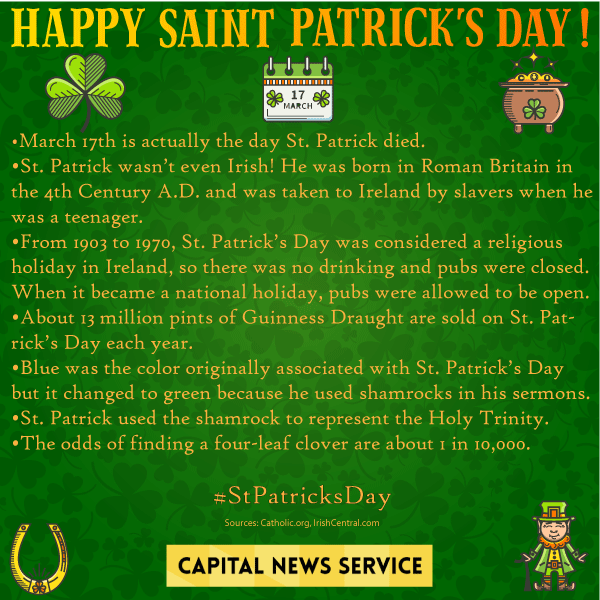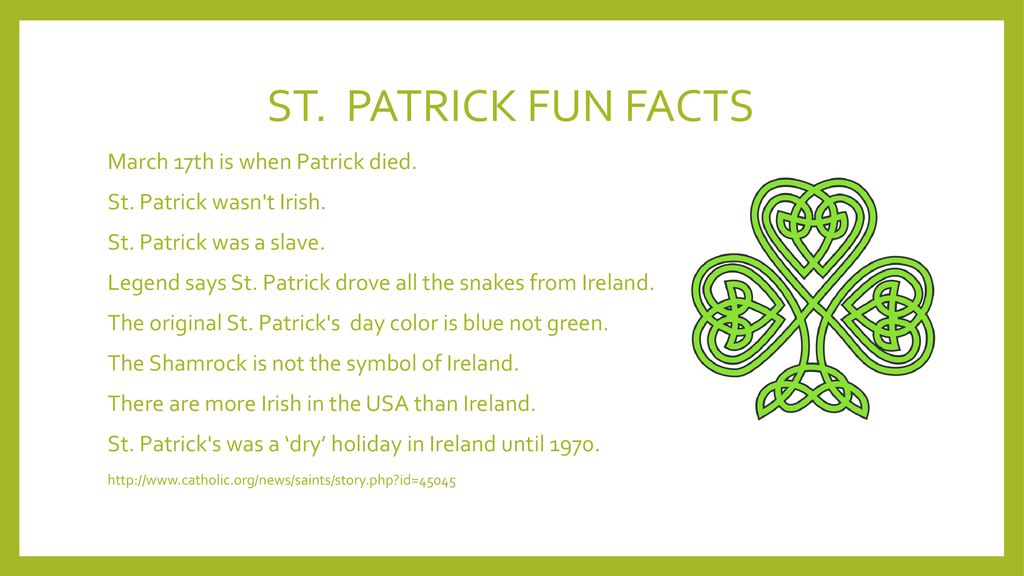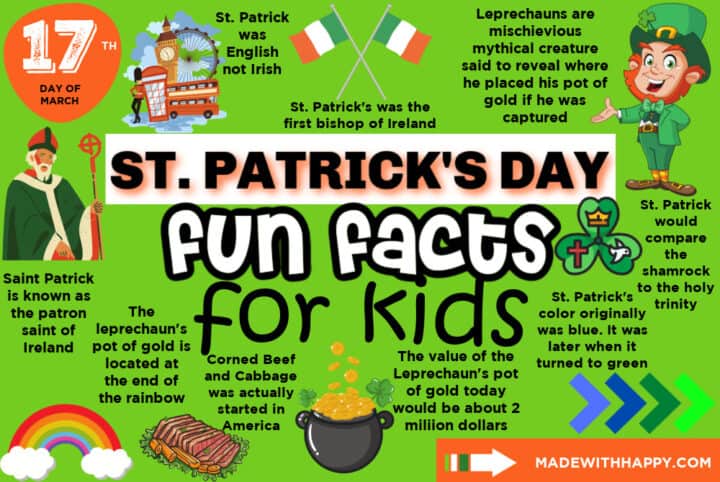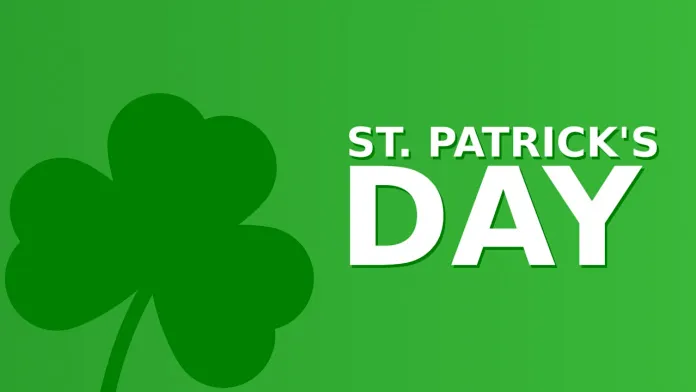Gallery
Photos from events, contest for the best costume, videos from master classes.
 |  |
 |  |
 |  |
 |  |
 |  |
 |  |
As the number of Irish emigrants in America grew, St Patrick’s Day also became an important event to connect with them home. The first definite St Patrick’s Day parade dates back to 1737, in Boston, Massachusetts, although new evidence suggests there may have been a St Patrick’s Day parade as early as 1601 in Spanish Florida. If caught, they would have to grant three wishes in order to gain their freedom. Leprechauns became the most famous of the Celtic fairies and are thus closely associated with Ireland and St. Patrick’s Day today. 9. The First St. Patrick’s Day Parade was in the United States A modern-day St. Patrick’s Day parade in New York City. Source Saint Patrick's Day Symbols. Symbols play a big role in Saint Patrick's Day celebrations. Each has its own story and significance. The Leprechaun's Pot of Gold: According to folklore, leprechauns hide their pots of gold at the end of rainbows. The Harp: The harp is a symbol of Ireland and is often associated with Saint Patrick's Day. The 200 th anniversary of St Patrick’s Day was marked in Sydney Opera House by making it green. 17. The first St Patrick’s Day celebration in the United States was held in Boston in 1737. Dyeing of the Chicago river on Saint Patrick’s day. Image credit – berni0004. 18. On this day, people usually eat corned beef and cabbage, and they The worldwide spread of St. Patrick’s Day was partially due to the 1845’s Great Potato Famine that forced more than a million Irish to emigrate. Today, more than 200 countries celebrate it. 10. St. Patrick’s Day Was Once a Dry Holiday. For much of the 20th century, St. Patrick’s Day was considered a strictly religious holiday in Ireland Discover 10 fascinating facts about St. Patrick, the patron saint of Ireland. Uncover the myths, legends, and little-known truths behind St. Patrick’s Day! TRENDING: Although St. Patrick's Day is Ireland's most famous holiday, Patrick is actually only one of three patron saints to Ireland. The other two are Saint Brigid, the patron of midwives and Irish nuns, and Saint Colmcille, who is also Scotland's patron saint. [9] Chicago, New York, London, and Dublin host the largest St. Patrick’s Day parades. [10] Below is a list of ten things that you may not have known about the special day celebrated on March 17 of each year. Some of these facts you’ll find surprising, while others are a little bit more expected, especially if you’ve participated in a St. Patrick’s Day festivity once in your live. And of course, Happy St. Patrick’s Day! 10 7. Blue Was the Original Color of St. Patrick’s Day. Before green became the signature color of St. Patrick’s Day, blue was actually the color associated with the holiday. Green became more popular over time due to Ireland’s nickname, “The Emerald Isle,” and the shamrock’s vibrant hue. 8. St. Patrick’s Day Used to Be a Dry Holiday 10 Surprising Facts About St. Patrick’s Day 6 minute read St. Patrick's Day: An aerial picture shot with a drone shows the Chicago River after it was dyed green on March 13, 2021. 6. St Patrick's Day is held on the day he passed away. In the Catholic tradition, the day a saint passes away is considered a holy day to celebrate their ascension into heaven. St. Patrick passed away on March 17 and it continues to be when St. Patrick's Day is held annually. This is one of the few St. Patrick’s Day facts that I did know..! The largest St. Patrick’s Day parade in the world takes place in New York City. The parade attracts a staggering two million+ people every year. 4. Ireland’s first parade. The very first St. Patrick’s Day in Ireland was held in County Waterford in 1903. 5. A national holiday Patrick - A Slave to Ireland, RTÉ One, St. Patrick's Day at 7pm - catch up afterwards via RTÉ Player. More stories on. Culture; st patricks day; Listicles; The rise of the St Patrick's Day Parade Fascinating St. Patrick’s Day Facts. St. Patrick’s original color was blue, not green. The color green became associated with him due to Ireland’s nickname, "The Emerald Isle." More than 13 million pints of Guinness are consumed worldwide on St. Patrick’s Day. The Irish name for St. Patrick’s Day is "Lá Fhéile Pádraig." Discover surprising St. Patrick's Day secrets: from its blue origins to snake-free Ireland! Uncover 10 mind-blowing facts about this global celebration that will make you the most interesting person at any March 17th party. St. Patrick’s Day always falls on March 17th, which is within the Lenten period. However, an interesting note is that restrictions on eating meat and drinking alcohol that are typically associated with Lent have sometimes been lifted on St. Patrick’s Day through general dispensations by Catholic churches. The largest St. Patrick’s Day parade outside of the U.S. and Ireland is held in Montreal, Canada. Moscow, Russia, has celebrated St. Patrick’s Day with a parade since 1992. St. Patrick’s Day became an official holiday in Ireland in 1903. Waterford, Ireland, held the first documented St. Patrick’s Day parade in Ireland in 1903. 12. What major Catholic holiday does St. Patrick's Day occur during? Answer: Lent . 13. There's a tradition that Irish government leaders give the United States president shamrocks on St. Patrick The earliest Saint Patrick’s Day parade took place in 1601 in what is now St. Augustine, Florida—not Ireland! 6. It’s a Religious and Secular Holiday. While it began as a religious feast day, Saint Patrick’s Day has evolved into a global celebration of Irish culture. 7. Guinness and the Holiday. On Saint Patrick’s Day, nearly 13 St. Patrick’s Day is the biggest Irish holiday celebration. Check out the top 10 St Patrick’s Day facts to learn more about this day.
Articles and news, personal stories, interviews with experts.
Photos from events, contest for the best costume, videos from master classes.
 |  |
 |  |
 |  |
 |  |
 |  |
 |  |